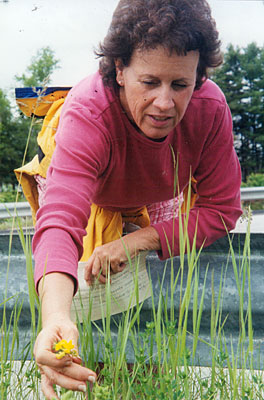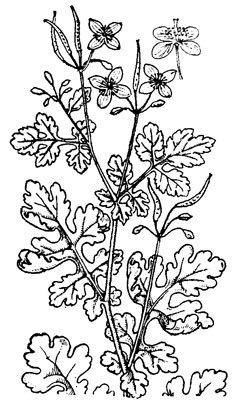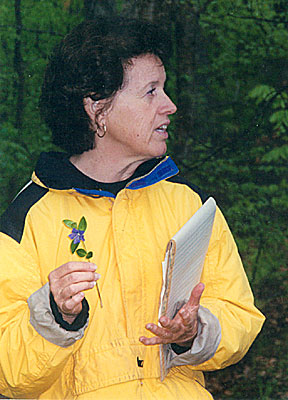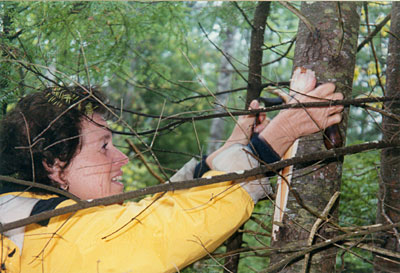 |
| Corinne Martin points out celandine, a medicinal plant with several anti-tumor properties. The flower has four yellow petals that are not as shiny as those of buttercup, and its leaves differ from those of buttercup. Photo by Joyce White. |
By Joyce White
Corinne Martin began learning about the use of herbs in healing in response to daughter Lara’s asthma, which began in early childhood. In addition, when Lara was 12, a car accident left her with a seizure disorder, and the asthma attacks had become increasingly severe. At one point, Lara was on a respirator, and medical personnel told Martin she couldn’t live through the night, that they could do nothing more for her daughter.
But Martin didn’t give up hope, and Lara lived. Within six months, she was free of life-threatening asthma attacks and seizures.
Martin had begun learning as much as she could about the traditional uses of medicinal plants in healing. At that time, nearly 30 years ago, little information was available, she says, but she studied Jethro Kloss’ Back to Eden, first published in 1939 and reissued in 1972. In the 670 pages of this book, which became a sort of “bible” for people in the 1970s who were determined to live by values different from the dominant culture, Kloss told readers how to live healthful lives in harmony with nature. Kloss, and the writings of Dr. Raymond Christopher, affirmed for Martin that she was on the right track and provided some of the information she needed about the use of medicinal plants.
She attributes Lara’s recovery to the walks they took together, often with Lara’s sister, Alison, to collect medicinal plants, walks through fields and woodland paths, beside brooks and back yards. They learned together, mother and daughters, and that changed their ideas about healing. Before that, Martin says, she had thought of healing as something that medical experts did to you. Once they began to learn about and use plant medicines that they made themselves, their attitude changed from being passive recipients to being active participants in their own healing.
The processes of learning, collecting plants and creating plant medicine were not the only things responsible for the healing, Martin adds. Healing also came from the whole process of establishing an intimate connection with the land through learning about plants. Martin also had Lara choose to use herbs when she needed them; supported her immune system, since she got many colds and pneumonias; and Martin helped her daughter “recognize how she was using her body to process or express her emotions, and gave her ‘permission’ or insight so that she could talk about things.” Some yoga breathing techniques and avoidance of mucousy foods, such as dairy, helped, as well.
 |
| Common celandine, Chelidonium majus. Illustration from Handbook of Plant and Floral Ornament from Early Herbals, by Richard G. Hatton, Dover, 1960. |
Since her childhood in Louisiana, Martin has been drawn to nature and has experienced the earth as nurturing, dependable, with an allure of something mysterious and magical. Only later, as an adult, did she identify the connection with the earth as healing. The use of plants in healing has added another dimension to her innate sense that nature is healing. She believes that healing and the earth are intimately connected, that the health of the earth reflects the health of its inhabitants and vice versa.
“We’re so blessed,” Martin says. “Within the 3-mile radius of my home, there are more than 120 medicinal plants. My house is filled with little bottles and jars of medicine made from plants – plants that we walk over every day.” Her home in Harrison, in the western Maine foothills, is not unusual in its abundance of medicinal plants, though. Rather, she wants people to know that healing plants – which many call weeds – grow everywhere, as close as our own back yards. Further, anyone who wants to learn to use them in their own healing can do so. However, she cautions that people begin by using small doses of any unfamiliar preparation and keep track of responses, since people respond uniquely to all substances, including herbs. If one tends toward sensitivities, try only one herb at a time, in small doses, and record responses scrupulously.
Now Corinne Martin, who holds a Master’s degree in applied anthropology with a concentration in ethnobotany and sustainable community, earns her living by teaching what she has learned – and continues to learn – about the use of earth’s bounty in healing, not only for the benefit of individuals but of the larger community of beings and of earth itself. She reaches a wide variety of people with her simple but profound messages that making intimate connection with the land and mindfulness of nature can bring us back to a sense of health, wholeness and joy in existence.
Earthmagic Herb School for Sustainable Health is the name she has given her enterprise, which, she says in her brochure, is “dedicated to fostering an understanding of the important role that medicinal plants can play in personal, environmental and community health.” It is also the name Martin first gave her book about finding and using local medicinal plants. Earthmagic was published in 1991 by Countryman Press in Woodstock, Vermont, then updated and published again in 2000 with the title Herbal Remedies from the Wild. She describes the book as a sharing of one person’s – her – experience in using herbs and is not meant to be a “medical book.”
 |
| Corrine Martin holds a periwinkle (Vinca minor) bloom. Declared unsafe by the FDA, it was used historically as a hemostatic (to stop bleeding). It also has ties to magic and protection against evil spirits. Joyce White photo. |
Martin has taught a variety of classes and guided herb walks. As she has done for several years, she offers herbal apprenticeships every summer during which apprentices learn about the anatomy and physiology of body systems and the effects of different herbs on these systems. They go into fields, back yards and woodsy places to observe medicinal plants from spring growth through flowering, fruiting and seed stages. They learn the basics of harvesting and making herbal preparations through hands-on experience with Martin’s guidance.
Between classes, people put into action some of the things they have learned: growing their own medicinal plants; collecting things like red clover blossoms and dandelion root for their own preparations and to dry for future use; making teas and tinctures, syrups and salves. Slowly, their own collections of bottles and jars and tins of herbal preparations grow. “It’s so satisfying to see those little bottles of good medicine I’ve made myself from nature’s gifts,” one student says.
Martin has a private practice in clinical herbalism and is a faculty member at the University of Southern Maine, teaching classes in holistic health and the connection between nature and spirituality. Many of her students are learning to be health care professionals, and Martin says she is glad for the conversation that has begun between conventional medicine and alternative approaches to healing.
Practitioners and patients alike benefit when health care professionals from both arenas work together, she says. She told her herbal apprentices about the necessity of understanding how the body works; “the body is so amazing.” In order to talk with conventional health care providers, she says it is useful to “wed the intuition” so important in alternative approaches like herbalism “to a foundation of practical understanding.” We need to know ourselves, she says, and to acquire as much knowledge as possible.
Martin says that she depends on the active compounds in herbs, but the amounts vary depending upon the conditions in the soil from which they were harvested. But that’s OK, she adds. Herbs work more slowly than pharmaceutical drugs, and, at least in part, the synergistic action of the many compounds in plants makes them effective in healing. When commercial operations separate the active compound in a plant – as when the interest in St. John’s wort led to separating and standardizing hypericum – sometimes what appears to be the most active ingredient actually is not, and some of the most useful compounds are omitted.
For Martin, the use of plant medicine is part of her larger concern for the health of the environment. She believes that when people begin learning about and depending upon plants as part of their health care, they become more aware of our shared responsibility to take care of earth’s diversity and abundance. “When we live intimately connected to the land, we’re a lot more apt to take care of our environment. We automatically become better stewards of the land.”
Ideally, Martin says, the use of herbs becomes part of everyday life. Herbalism has to be workable for people, though, for that to happen, so she suggests starting with just one plant. Learn about its use in healing — red clover, echinacea, dandelion, for example, plants that are easy to identify and find or grow. “Herbalism is about the richness we find growing all around us,” she says. “It’s about discovery, wonder, joy and mystery. It’s not against conventional medicine.”
 |
| Martin removes some bark from white pine. In the spring, the cambium layer is used to make an expectorant and antibacterial cough syrup. Photo by Joyce White. |
Five Favorite Herbs
I asked Corinne Martin if she could recommend five herbs that are most important to her or to the people she sees. “There are lots,” she said, but she listed the following five as being most “on call” for folks she sees and the five that she uses most:
Astragalus
Valerian
St. John’s wort
Dandelion
“At least these are some of the most basic,” she said. She added, “Since one of my main concerns is to help people appreciate the wealth of healing we have under our feet, I suggest that people just get to know what’s out there – what grows around them – then find the status of particular plants and help to preserve them either by using them in their everyday health or by growing the herbs that are threatened and helping to reintroduce them when appropriate into the wild.”
– Joyce White